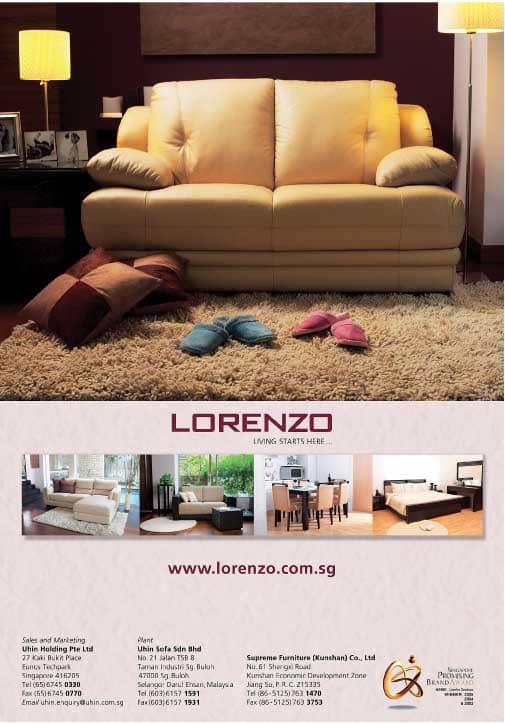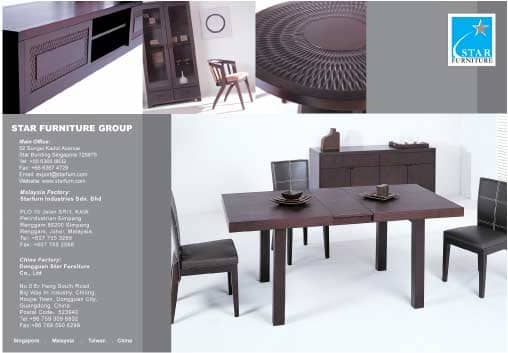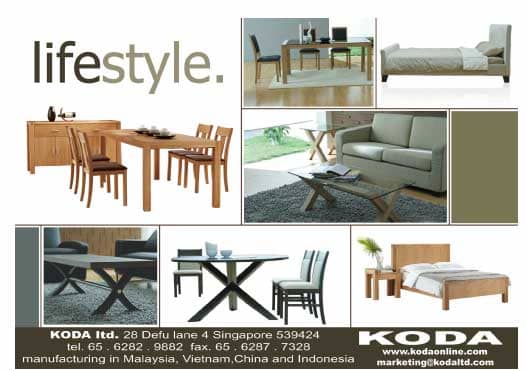Companies design & keep headquarters in Indonesia for political & financial stability, manufacture in Asia for price, and then sell to the world.
Text and Research by: Frederic Chouraki and Nicolas André. Project Coordination: Mary Luna Matuk. Visit us at www.focusreports.net. For more information contact: info@focusreports.net
“Design in Singapore, manufacture in Asia, sell to the world”: The model promoted by James Koh, President of the Singapore Furniture Industries Council (SFIC), reflects the specificities as well as the new challenges the Singaporean furniture industry is facing in order to stay ahead of the game. The uncertainties in both the local and global economic outlook as well as growing competition from regional and international furniture players, serve as a constant challenge for the industry. “The furniture industry has been part of Singapore’s economic landscape since the 1960s,” reminds Mr. Koh. “It was among the pioneers in the national industrialization drive. Today, it remains as one of the most established industries.” Starting as a cottage industry, it has notably progressed to become more and more professional.
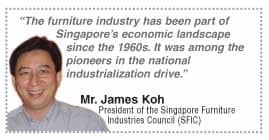
Relocating Manufacturing
In the early 1990’s, the sector faced a labor shortage – both skilled and unskilled along with rising operational costs. This posed a serious challenge. The furniture sector lagged behind the overall Singapore economy that grew, for example, 8.1% in 2004 when compared to 2003. With emerging trends toward globalization and low entry barriers, the players faced worldwide competition. This changed the rules of the game.
“Singapore is not the ideal place to manufacture because operating costs are too high so we strongly encourage our members to relocate their manufacturing facilities to neighboring countries with lower overhead and readily available resources”, asserts Mr Koh whose SFIC, represents 95% of furniture manufacturers in Singapore. 65% of them have already built subsidiary manufacturing plants in the region including Singapore, Indonesia, China, Vietnam and Myanmar. This strategy helped these manufacturers to stay competitive by transferring lower value-added and labor-intensive activities elsewhere while keeping their headquarters in Singapore, to take advantage of Singapore’s strong infrastructure, good reputation and highly developed financial services.

“Our country is politically stable, explains Loh Khum Yean, Chief Executive of Spring Singapore, the lead agency charged with developing Singapore’s furniture industry. We have a strong economic infrastructure, making us one of the most well-connected countries in the world. We have also excellent sea, air and telecommunications links and our port is the busiest container port in the world.” Besides its strategic location and pro-business environment, Mr. Loh points out the added strengths of Singapore’s highly capable entrepreneurs, strong reputation for trendsetting furniture design and their companies’ excellent reputation for integrity and reliability. “It is this high level of trust and reliability that has enhanced the standing of Singapore-made furniture in the world,” adds Mr Loh.
Family Business To Global Player
The majority of Singapore’s furniture businesses started as family companies. Star Furniture is no exception. In a competitive global environment, the majority of them had no other choice than to turn into global professional companies. “The main advantage of working in a family company relies on the fact that we can share ideas more openly at all times: there is no “on or off” office hours. Five of my nine brothers work with me and we share positive and negative ideas until we get to a final decision,” explains Mr. Kenny Koh, Executive Director of Star Furniture Group.
Star Furniture started in 1981 and made many adaptations during the Asian financial recession of 1997. “During this period we diversified from only manufacturing to retailing and opened our own warehouse and showroom, remembers Mr. Koh. We were successful because we controlled the entire production line, from the factories to the warehouse. This gave us a very good “push”.
The company is highly focused on the export market. “50 % of our company sales are coming from export. So today we are taking close care of them. Today exports contribute more to our total turnover than our retail activity,” boasts Mr Koh. Their main markets are located in Europe, especially the UK, Holland and Spain. Star Furniture also has an important presence in Australia, the SEA region, Africa and Latin America. And America is not forgotten, as Kenny Koh explains: “For a long time, we didn’t pay much attention to the US market as we believed our limited output capacities weren’t sufficient. But today with our new facilities in China we are able to tackle this market both in terms of capacity and pricing.”
HTL is the perfect example of a family business turning to a prominent global player. The company was founded in 1976 as a small furniture manufacturer by the three Phua brothers. It has become, in less than 30 years, one of Singapore’s most dynamic and world-oriented furniture companies, publicly listed and generating revenues of $500 million. “We are glad that HTL has been recognized for all its achievements and was selected by Forbes Global magazine for three consecutive years as one of the world’s 200 Best Small Companies, a rare recognition for a small Singapore company,” recalls Mr Yong-Tat Phua.

Now fully vertically integrated, HTL is today a worldwide leader in sofa manufacturing. But, in order for the company to keep pace with the growing worldwide demand for their products, they had to increase their capacity. Thus, last year, they commissioned their eighth manufacturing facility in Ding Shan Hu, China. They are also planning to invest an additional $5 million this year in China to increase the output of their tannery.
“With nine marketing offices across several continents, HTL is presently exporting to more than 40 countries”, points Mr Phua. America is definitely the largest growth market for HTL. Their revenue from the US market grew a record 61% in 2004. “Our unique selling proposition is to continually strengthen our relationships with our business partners—by delivering consistent quality products, and providing customer-focused service, all geared towards meeting and exceeding our business partners’ expectations, and enhancing their success,” concludes Mr Phua.
A Competitive Nerve Center
Amidst aggressive competition from low-cost manufacturers, Singapore’s potential for furniture quality and design has been addressed. In that regard, the SFIC has been a key strategic driver for the industry, ensuring that its players are able to stay ahead of a competitive marketplace.
Among its missions, the Council organizes a showcase of world-class industry players, facilitates strategic East-West networking and proposes integrated solutions as well as ideas for customized products and services.
In 1994, SFIC set up the Singapore Furniture Industry Park in Kunshan, the first private sector-led specialized furniture industry park in China. The Furniture Industry Capability Upgrading Program (ICAP) was launched in 2003 with the support of Spring Singapore. It helped to create a number of design development initiatives to nurture and increase Singapore’s pool of furniture design talent.
In SFIC we want to bring foreign companies into Singapore and display their products in order to increase, even further, our companies’ exposure,” explains James Koh. “Thus we become a nerve center where best practices are showcased. On the design side, our objective is to attract designers from all over Asia, and even other regions of the world.”
Emblematic of SFIC’s vision and initiative is the creation of the International Furniture Fair Singapore, considered as one of the most up-to-date shows in terms of international design.
“The presence of 475 companies representing 34 different countries of which a whopping 82% are repeat exhibitors reaffirms the global furniture industry’s recognition of the fair’s status as the “Best Show in Asia,” noted The Minister for Trade and Industry, Mr. Lim Hng Kiang at the opening of the 2005 edition in March. “Because we want our show to be the best in the region, we ask the exhibitors to design original, creative, and sophisticated booths. On our side we also provide a consistent environment, giving them space, with large walkways for buyers’ convenience,” adds Mr Koh, who concludes, “We do not want to display cheap products, but rather competitive products on a global basis.”
Singapore As An International Hub
On a larger scale, SFIC aims to position Singapore as a hub for Asian furniture and turn it into an Asian buying circuit for the global furniture trade. “We want to further consolidate Singapore’s furniture and design hub status in Asia by developing a trade, design and export-orientated International Furniture Centre (IFC), in order to provide total solutions for the global furniture market,” assesses Mr Koh. This hub will consist of export showcases whereby the showrooms will provide a one-stop year round platform for top international, regional and local brands, and a meeting place for designers to come and share ideas.
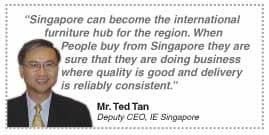
“Singapore can become the international furniture hub for the region,” adds Mr. Ted Tan, Deputy Chief Executive Officer of IE Singapore, a State Agency that helps companies that are willing and able to go international successfully. “When people buy from Singapore they are sure they are doing business with a trusted hub where quality is good and delivery is reliably consistent. There is a lot of potential for our furniture to reach out to the world, and we would like to bring buyers to see and feel what our industry has to offer,” concludes Mr Tan.
Design and quality In Singapore
Koda is undoubtedly one of the most progressive furniture companies in Singapore. Its impressive growth as well as its focus on design has made this 20-year-old company a reference point for the sector. Following the major trend of moving production offshore, Koda has relocated its operations to regions offering good but cheaper labor and abundant natural resources. “We first invested in Singapore in the mid 80s,” remembers Ernie Koh, Senior Vice President & Marketing Manager. “In the early 90’s, we chose Vietnam which currently contributes most to our turnover, with 40% of our products coming from there. We have invested recently in continental China, but Vietnam should still remain our prime production location.”

Until 1999, Koda was a traditional furniture manufacturer relying on key customers for its sales. The company quickly realized that this strategy was risky. They therefore decided to add value to their offerings, including but not limited to the areas of logistics and design. They also turned from OEM to ODM.
“We chose to become a very modern furniture manufacturer with our designs being fashion and lifestyle related. We also decided to reconsider how our organization and our factories worked, to become more flexible and adapt to the needs of our customers. Today, no customer takes up more than 20% of our turnover.”
Koda now enjoys economies of scale through low cost production, mass customization and world based product distribution. “Our creativity and design today equally matches our technical expertise acquired for the past 20 years as we have invested heavily in R&D and production technology,” adds Ernie Koh.
Design and final product quality are also emphasized by Uhin Holding, that very early understood the necessity of providing its customers with a valuable and unique product. “We keep on changing and upgrading to provide our customers with good and new ideas and designs,” confirms James Goh, Group Deputy Managing Director of Uhin Holding, which exports its products under the Lorenzo brand. “Of course pricing remains an important success factor, but for us, quality and after sales service and design are the most important factors of success.” Uhin’s team is, indeed, particularly proactive and skilled in design. “We renew our designs by going to international shows to grasp upcoming trends, fashionable colors, new materials used in order to get inspiration and ideas for our new products,” adds Mr Goh.
As with Koda, Uhin Holding has followed a strategy of relocation. Its manufacturing plants are set in Singapore and in China where there are two new plants including a traditional wood factory that manufactures casegoods as well as occasional furniture pieces to complement their core business, leather upholstery. “Our wood-based furniture designs are quite excellent in the Singapore context,” asserts James Goh. “Although we chose to manufacture abroad, our headquarters are still based in Singapore because we believe this is the most convenient place due to the good infrastructure as well as the level of development of the financial sector. These factors provide opportunities to finance our growth and the activities of our subsidiary companies.”

Facing the prospect of 20 % growth this year, Uhin Holding Holding is on the lookout for new markets. 40% of their sales already come from export markets, mainly Australia, Japan and Canada. Today, Europe and the USA are targeted with a completely new range of products.
The importance of creating a recognizable Singaporean brand as a competitive advantage is shared by all participants in Singapore’s furniture sector. The Chief Executive of Spring Singapore, Loh Khum Yean notes that, “With the businesses being more professionally managed, Singapore’s furniture companies are also building up their brand names. Strong branding has enabled them to capture a larger share of the regional and global markets.”
Kiat Lee is another well and long established family business which has proved its seriousness for more that 25 years in the domestic and export markets thanks to its modern management and a growing product range, allowing for flexibility and support to customers. The company is also looking toward the US. “We know that trying to sell to the largest retailers and importers in the US market is very appealing, but because of our more modest size,” explains Andrew Ng, Managing Director, “we are now focusing on meeting the needs of medium size customers to whom we can provide better follow-up and value added in the products we supply.”
Their main markets are currently the Middle East, representing 60% of their exported sales volume, Italy, France, the UK and Canada. Kiat Lee usually sells to importers met at international furniture fairs in Singapore, China and Cologne. To increase their value position in the business, Kiat Lee just started to explore the possibility of working with French designers. “It is an industry dream to become an ODM,” notices Mr Ng. “But developing a range of high-perceived value items is a long-term issue, and we’ve just started. Now we have to see if our customers can accept this idea.” And it is only a beginning. In 2005, Kiat Lee managed to conquer the Italian market with its promotional furniture line.
FEATURED SINGAPORE COMPANIES (see below)
Lorenzo - uhin.enquiry@uhin.com.sg
Star - expo@starfurn.com
Koda - marketing@kodaltd.com
